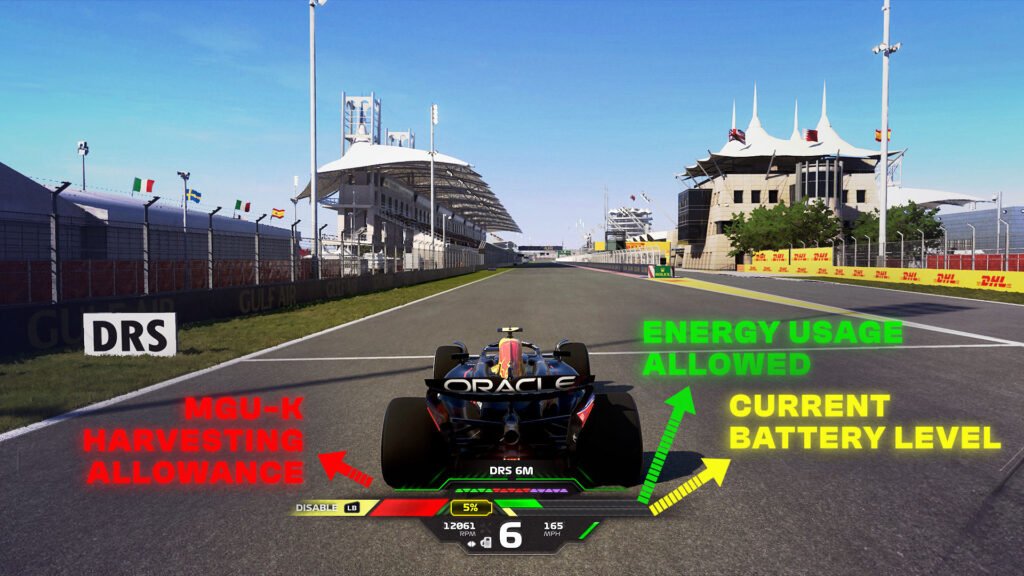What is ERS in F1 24?
In F1 24, ERS is a car’s Energy Recovery System, consisting of two Motor Generator Units (MGUs) that collect the waste energy from the turbocharger (MGU-H) and braking system (MGU-K).
The energy is stored in a battery (Energy Store – ES) which can boost the car’s power by 160 bhp for 33s per lap.
In F1 24, ERS Deploy relates to how much battery assistance is used by your car’s powertrain, boosting speed and affecting the energy recovery rate (or battery charging, in simple terms).
ERS management is crucial to lap time in F1 24, so if you use a gamepad you should map ERS controls to your right analog stick, as adjusting this via the MFD can cost vital tenths of a second.

What ERS modes are there in F1 24?
F1 24 has four ERS Deploy modes for players to tinker with while driving. These are:
- None
- Medium
- Hotlap
- Overtake
What effect does each ERS mode have in F1 24?
- None: offers the greatest rate of battery charging but the smallest amount of on-throttle battery assistance.
- Medium: is a balanced map providing moderate boost and battery regeneration.
- Hotlap: increases battery assistance and is ideal for setting fast lap times with minimal fuss.
- Overtake: offers a huge short-term boost to help players (unsurprisingly) overtake other cars and can be used strategically to set the fastest lap times.

Are there limits to ERS use in F1 24?
Yes, cars in F1 24 (and in Formula 1) are limited on the amount of energy they can recharge during a lap through the MGU-K (denoted by the red bar on the bottom left of the screen), and on the amount of battery that can be deployed on a single lap (green bar on the bottom right of the screen).
The battery level is represented by a yellow bar and can be topped up to varying degrees during a lap depending on the selected ERS mode.
Once the green bar is reduced to zero, you can no longer deploy any more ERS battery charge on that lap. Likewise, once the red bar is full you cannot charge the battery more via braking, as your allotted amount of charging for that lap has been used up. The battery will still charge through the MGU-H, however, making lifting and coasting very important.
The key is to balance ERS use to ensure you use the maximum allowed energy on every lap while leaving yourself enough battery charge to fend off attacks over a whole circuit.
It’s also possible to improve the efficiency and effectiveness of your ERS systems by developing them further in the game’s career mode.

Tips for ERS use in F1 24
- In qualifying, deploy as much ERS as possible just before you begin your flying lap. Doing this maximises your speed as you start a quick lap without affecting the energy available for the next lap: your ERS Deploy allowance resets once you cross the start/finish line.
- Using low-downforce set-ups helps charge your battery: low wing levels allow higher top speeds, which increases braking distances and in turn increases battery charging through the MGU-K.
- Lift and coast (this refers to the technique where you lift off the throttle completely before a corner’s braking zone, using the car’s aerodynamic drag to slow the car down) minimises energy recovered through the MGU-K during braking, meaning the red bar takes longer to fill.
How does Engine Braking affect ERS in F1 24?
A new set-up feature for F1 24 is Engine Braking. Increasing this value in the car set-up screen allows more battery charging at the expense of increased oversteer on corner entry. Lower values provide a safer driving feeling but the battery will recharge less under braking.
Tips for using engine braking in F1 24
- Lift and coast is an even more effective way of charging your car’s battery in F1 24 while using high engine braking settings . This saves fuel and energy allowance, while also helping charge the battery via the MGU-H. The knock-on effect is the red bar will fill up slower since less MGU-K energy is being harvested.





Chat with the Community
Sign Up To CommentIt's completely Free